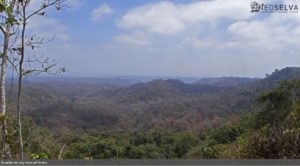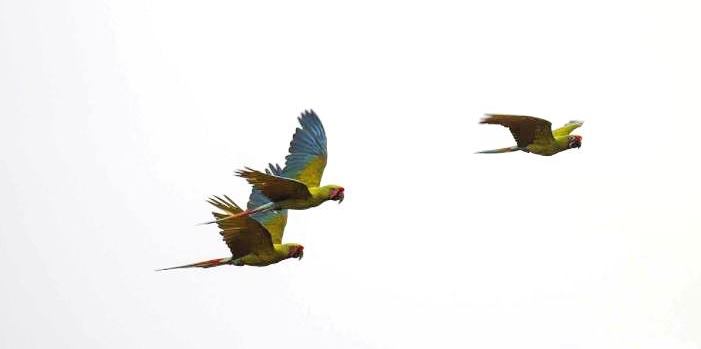Beginning in the 1960s, La Cemento Nacional (National Cement Company) bought up land in Cerro Blanco (near Guayaquil, Ecuador) to establish a limestone mine quarry on part of the land. The remaining extension of approximately 1,820 ha was nominally protected by the head of security of the adjacent cement plant with a group of 10 workers who periodically maintained boundary fences, planted trees, etc.
 In 1989, at the request of La Cemento Nacional, the Ecuadorian Ministry of Agriculture and Livestock was asked to protect approximately 2,000 ha of Cerro Blanco as a protected forest. While no government funding was forthcoming as a result, the designation did provide a legal basis for protecting Cerro Blanco especially against later attempts to take over by force parts of the area by land traffickers wanting to convert the protected forest into urbanized areas.
In 1989, at the request of La Cemento Nacional, the Ecuadorian Ministry of Agriculture and Livestock was asked to protect approximately 2,000 ha of Cerro Blanco as a protected forest. While no government funding was forthcoming as a result, the designation did provide a legal basis for protecting Cerro Blanco especially against later attempts to take over by force parts of the area by land traffickers wanting to convert the protected forest into urbanized areas.
The first attempt to write a management plan for Cerro Blanco failed. Instead of focusing on the principal objective of protecting native dry forest, the plan called for exploiting the remaining tropical hardwoods in Cerro Blanco and was rejected by La Cemento Nacional.
In 1990, La Cemento Nacional in conjunction with Fundación Natura, the principal Ecuadorian nonprofit conservation organization at the time, requested assistance from the Peace Corps for a volunteer to assist in carrying out the initial planning for the protected forest and assist in setting up some of its management programs.
The author of this article (Eric Horstman) was sent to work initially for three months to research and prepare management guidelines for Cerro Blanco. It turned into 27 years.
The management guidelines included a preliminary land use zoning ranging from intensive use areas to strict scientific areas. In between the two was a recuperation zone where the natural processes of forest regeneration would continue, to a restoration zone focusing on the exotic pasture grasses.
The principal management programs in the guidelines were also outlined including an environmental education and interpretation program recognizing the close proximity of Cerro Blanco to the city of Guayaquil and its easy access from the coastal highway linking the city to nearby beaches.
The existence of a tree nursery on site that produced some native tree species utilized mainly in urban green space programs was also incorporated with a new focus on producing native dry forest trees for the Cerro Blanco restoration program. The globally endangered Great Green Macaw Ara (ambiguus guayaquilensis) was also identified as the conservation symbol of the Cerro Blanco Protected Forest.
A core group of five park guards were also formed and work began to restore forest in tree plantings along internal access roads within the reserve. The visit of several important Neotropical scientists under the auspices of the Rapid Areas Assessment Program of Conservation International and their subsequent recommendation to protect and expand the reserve provided a needed boost.
Beginning in 1993 the author with the support of the CEO of La Cemento Nacional worked to consolidate the conservation gains made, including the construction and manning of the first backcountry guard station, the construction and staffing of an on-site office and the expansion of the dry forest restoration program through the establishment of enrichment parcels in both abandoned pasture lands as well as secondary scrub vegetation.
A botanical inventory under the auspices of the National Herbarium was carried out, and the first known Great Green Macaw nest was protected with 24 hours a day vigilance leading to the successful fledging of two chicks.
The following case study documents 27 years of conservation and restoration efforts in Cerro Blanco.

